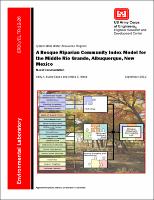Please use this identifier to cite or link to this item:
https://hdl.handle.net/11681/7166Full metadata record
| DC Field | Value | Language |
|---|---|---|
| dc.contributor.author | Burks-Copes, Kelly A. | - |
| dc.contributor.author | Webb, Antisa C. | - |
| dc.date.accessioned | 2016-03-28T14:35:26Z | - |
| dc.date.available | 2016-03-28T14:35:26Z | - |
| dc.date.issued | 2012-09 | - |
| dc.identifier.uri | http://hdl.handle.net/11681/7166 | - |
| dc.description | Technical report | - |
| dc.description | Over the last century, the Middle Rio Grande was subjected to significant anthropogenic pressures producing a highly degraded ecosystem that today is poised on the brink of collapse. In 2002, the U.S. Army Corps of Engineers (USACE) (Albuquerque District) was authorized to study the river and prepare an Environmental Assessment (EA), as required under the tenets of the National Environmental Policy Act (NEPA), to evaluate the effects of proposed ecosystem restoration alternatives on the watershed’s significant resources. As part of the process, a multi-agency, multidisciplinary evaluation team was established to formulate alternatives that would address three critical problems: 1) hydrological alterations, 2) bosque (riparian) ecosystem degradation, and 3) the loss of key ecological services to the surrounding community. Between 2005 and 2008, this team designed, calibrated, and applied a community-based index model for the bosque riparian ecosystem using field and spatial data gathered from 27 reference sample sites scattered across the watershed. This unique community was modeled using 23 individual variables combined into numerous predictive community functional components (i.e., Biotic Integrity, Hydrology, and Spatial context) capable of capturing the changes to ecosystem integrity in response to changes in land and water management activities proposed by the study. The intent of this document is to provide the scientific basis upon which the model was developed, and describe the 3-year-long process the team undertook to complete this effort. Although some results are presented here to demonstrate and verify the veracity of the model’s calibration and subsequent outputs, readers interested in the application of this model on the Middle Rio Grande project must refer to a second report entitled, “Middle Rio Grande Bosque Ecosystem Restoration Feasibility Study Habitat Assessment Using Habitat Evaluation Procedures (HEP): Analyses, Results and Documentation,” which is currently in preparation. | - |
| dc.publisher | Environmental Laboratory (U.S.) | - |
| dc.publisher | Engineer Research and Development Center (U.S.) | - |
| dc.relation | http://acwc.sdp.sirsi.net/client/en_US/search/asset/1011341 | - |
| dc.relation.ispartofseries | ERDC/EL ; TR-12-26. | - |
| dc.rights | Approved for public release; distribution is unlimited. | - |
| dc.subject | United States. Army. Corps of Engineers. Albuquerque District | - |
| dc.subject | Bosque Riparian | - |
| dc.subject | Ecosystem restoration | - |
| dc.subject | Environmental assessment | - |
| dc.subject | Middle Rio Grande River | - |
| dc.subject | National Environmental Policy Act (NEPA) | - |
| dc.subject | System-Wide Water Resources Program | - |
| dc.title | A bosque riparian community index model for the Middle Rio Grande, Albuquerque, New Mexico: model documentation | - |
| dc.type | Report | - |
| Appears in Collections: | Technical Report | |
Files in This Item:
| File | Description | Size | Format | |
|---|---|---|---|---|
| ERDC-EL TR-12-26.pdf | 10.85 MB | Adobe PDF |  View/Open |